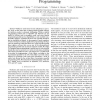1559 search results - page 113 / 312 » The Semantics of Future and Its Use in Program Optimizations |
SIGSOFT
2002
ACM
15 years 10 months ago
2002
ACM
Program slicing is a potentially useful analysis for aiding program understanding. However, slices of even small programs are often too large to be generally useful. Imprecise poi...
PDP
2010
IEEE
15 years 4 months ago
2010
IEEE
—Multicore nodes have become ubiquitous in just a few years. At the same time, writing portable parallel software for multicore nodes is extremely challenging. Widely available p...
160
click to vote
ICDE
2007
IEEE
15 years 11 months ago
2007
IEEE
requirement. Furthermore, programming using sequence constructs normally produce nested structures and The current approachfor modeling synchronization in scattered code, especiall...
BMEI
2008
IEEE
15 years 4 months ago
2008
IEEE
Multiple sequence alignment is the most fundamental task in bioinformatics and computational biology. In this paper, we present a new algorithm to conduct multiple sequences align...
VMCAI
2004
Springer
15 years 3 months ago
2004
Springer
Typed Assembly Languages (TALs) can be used to validate the safety of assembly-language programs. However, typing rules are usually trusted as axioms. In this paper, we show how to...



